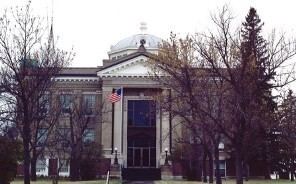Congressional district At-large Website www.co.mountrail.nd.us Population 9,376 (2013) | Area 5,030 km² | |
 | ||
Founded January 4, 18731892 (eliminated)January 29, 1909 (reestablished) University Nueta Hidatsa Sahnish College Points of interest Broste Rock Museum, Lostwood National Wildlife R, Crow Flies High Butte Historic S | ||
Mountrail County is a county located in the northwestern part of North Dakota, United States. As of the 2010 census, the population was 7,673. Its county seat is Stanley. The county was originally created in 1873, then removed in 1892, annexed by Ward County. It was re-created and organized in 1909.
Contents
- Map of Mountrail County ND USA
- History
- Geography
- Adjacent counties
- Major highways
- National protected areas
- 2000 census
- 2010 census
- Cities
- Unincorporated communities
- References
Map of Mountrail County, ND, USA
Oil production from the Bakken formation in the early 21st century has attracted workers and reversed decades of population decline in the county. From 2010 to 2015, especially, population has markedly increased, creating its own strains.
History
Mountrail County was first established in 1873 (as Mountraille County) by the Dakota Territorial Legislature. The boundaries extended from the Missouri River north to the border with Canada. It remained a county when North Dakota became a state in 1889, but in 1892 North Dakota Legislature authorized neighboring Ward County to take over all of Mountrail's territory, and this county was eliminated.
At the November 3, 1908, general election, a vote was held in Ward County on whether to recreate Mountrail with different boundaries. The vote was 4,207 to 4,024 in favor of the new county, but North Dakota's Attorney General sued the Secretary of State over the validity of the vote. Organization of the new Mountrail County was delayed until the Supreme Court affirmed the vote in January 1909.
Geography
According to the U.S. Census Bureau, the county has a total area of 1,942 square miles (5,030 km2), of which 1,825 square miles (4,730 km2) is land and 116 square miles (300 km2) (6.0%) is water.
Mountrail County is one of several western North Dakota counties with significant exposure to the Bakken Formation in the Williston Basin.
Adjacent counties
Major highways
National protected areas
2000 census
As of the census of 2000, there were 6,631 people, 2,560 households, and 1,753 families residing in the county. The population density was 4 people per square mile (1/km²). There were 3,438 housing units at an average density of 2 per square mile (1/km²). The racial makeup of the county was 65.99% White, 0.09% Black or African American, 29.98% Native American, 0.21% Asian, 0.05% Pacific Islander, 0.26% from other races, and 3.42% from two or more races. 1.31% of the population were Hispanic or Latino of any race. 37.1% were of Norwegian and 15.4% German ancestry.
There were 2,560 households out of which 31.80% had children under the age of 18 living with them, 51.80% were married couples living together, 11.80% had a female householder with no husband present, and 31.50% were non-families. 28.50% of all households were made up of individuals and 14.60% had someone living alone who was 65 years of age or older. The average household size was 2.53 and the average family size was 3.09.
In the county, the population was spread out with 28.10% under the age of 18, 6.80% from 18 to 24, 23.20% from 25 to 44, 24.20% from 45 to 64, and 17.70% who were 65 years of age or older. The median age was 40 years. For every 100 females there were 96.80 males. For every 100 females age 18 and over, there were 95.10 males.
The median income for a household in the county was $27,098, and the median income for a family was $31,864. Males had a median income of $24,750 versus $20,844 for females. The per capita income for the county was $13,422. About 14.00% of families and 19.30% of the population were below the poverty line, including 23.40% of those under age 18 and 18.30% of those age 65 or over.
2010 census
As of the 2010 United States Census, there were 7,673 people, 2,793 households, and 1,852 families residing in the county. The population density was 4.2 inhabitants per square mile (1.6/km2). There were 4,119 housing units at an average density of 2.3 per square mile (0.89/km2). The racial makeup of the county was 65.6% white, 30.6% American Indian, 0.2% black or African American, 0.2% Asian, 0.8% from other races, and 2.6% from two or more races. Those of Hispanic or Latino origin made up 3.7% of the population. In terms of ancestry, 36.6% were Norwegian, 24.4% were German, 6.6% were Irish, and 0.8% were American.
Of the 2,793 households, 31.1% had children under the age of 18 living with them, 48.3% were married couples living together, 11.4% had a female householder with no husband present, 33.7% were non-families, and 28.3% of all households were made up of individuals. The average household size was 2.55 and the average family size was 3.11. The median age was 37.0 years.
The median income for a household in the county was $53,912 and the median income for a family was $63,238. Males had a median income of $43,386 versus $29,432 for females. The per capita income for the county was $25,762. About 13.5% of families and 16.5% of the population were below the poverty line, including 24.2% of those under age 18 and 14.2% of those age 65 or over.
